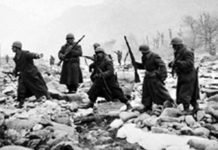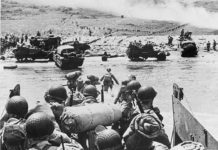The flawed strategy of General Crook lead to his defeat in the Battle of the Rosebud and contributed to Custer’s demise at the Battle of the Little Bighorn.
The Battle of the Rosebud on June 17, 1876 cannot be considered an isolated confrontation between the US army and the Native Americans it was tasked to defeat and force onto reservations established by the government. In light of what was to follow in the weeks after the Rosebud, serious doubts were cast on the army’s knowledge and ability to force one of the largest Native American villages in recorded history to submit to defeat. The mistakes made on that day indirectly led to George Custer’s loss at the Battle of the Little Bighorn.
A Flawed Battle Strategy at the Rosebud
Following the Battle of the Rosebud, Crook wanted to continue along Rosebud Creek in search of the Indian village that supposedly was nearby. He assumed that such a village had prompted the Sioux and Cheyenne to attack him at the start of the Rosebud battle in its defense. No such village existed on Rosebud Creek. It was, in fact, located twenty miles away on the Little Bighorn River.
Crook was saved from finding that out firsthand. His scouts refused to accompany him in search of the camp for fear they would be ambushed along the way. He also had many wounded soldiers in his command and was very low on rations and ammunition. As a result, Crook was forced to return to his base camp, dozens of miles to the south. He had planned to wait there for supplies and reinforcements before continuing his pursuit of the Indians. Crook would not take to the field again until August of 1876 and was of no benefit to Custer or Terry during the Battle of the Little Bighorn.
Crook’s Empty Victory
Crook would later boast in a dispatch to his superior, General Phil Sheridan, that he was victorious in driving the enemy from the field during the Battle of the Rosebud. Although the Indians had withdrawn, they had done so on their own terms while suffering only minor losses. His objectives of pressing the Indians into submission or assisting other commanders in the field to do so were lost. The reality was that Crook had suffered a defeat and his men knew it. After the battle, they began to secretly call him “Rosebud George.”
One of his subordinate officers, Captain Anson Mills, later wrote “all of us made very brief reports of the battle, having little pride in our own achievement.” The New York Herald echoed Mills’ sediments in a scathing editorial: “the retreat of Crook southward after the battle left Sitting Bull free to choose the future seat of his operations, making him a very ‘unknown quantity’ indeed.” Crook’s hope of overshadowing his dismal defeat in the Battle of Powder River was also gone. The only objective obtained over that engagement was to account for all of his dead and wounded after the fighting had stopped.
For Custer, Too Little Too Late
The true value of Battle of the Rosebud was the intelligence Crook gained about the size and ferocity of his enemy. However, no direct communication occurred between him and the other commanders involved in the 1876 offensive against the Sioux. Crook instead warned Sheridan of the Indians’ ability to fight who, in turn, attempted to relay the information to Terry, Custer, and Gibbon closing in on the same Indian village from the north. Unfortunately, they did not receive it until it was too late. George Custer and the Seventh Cavalry would suffer one of the worst defeats in the history of the army on June 25, in part because they had no idea just how big the hornet’s nest Crook had stirred up was. General Terry did not receive Sheridan’s dispatch concerning the Battle of the Rosebud until June 30.








